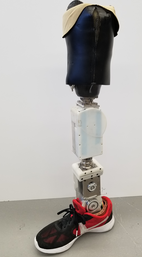Human musculoskeletal system serves the important purposes of supporting the body weight and powering joint and fully-body movements. An individual with lower limb loss relies heavily on a leg prosthesis to restore the lost limb functions and stay mobile. However, most leg prostheses in current use are unpowered, which may cause significant inconvenience in the amputee users' daily life. For example, these unpowered prostheses cannot propel the amputee users forward in walking, and cannot push them up while standing up or climbing stairs.
Despite the emergence of powered robotic lower-limb prostheses in recent years, the adoption of these devices has been slow. Robotic prostheses are usually much heavier than traditional passive prostheses, while the duration of operation before recharge is much shorter. The robotic prostheses are also much more expensive. To address these issues, we have been investigating innovative methods to improve the dynamic performance of robotic lower-limb prostheses.
Despite the emergence of powered robotic lower-limb prostheses in recent years, the adoption of these devices has been slow. Robotic prostheses are usually much heavier than traditional passive prostheses, while the duration of operation before recharge is much shorter. The robotic prostheses are also much more expensive. To address these issues, we have been investigating innovative methods to improve the dynamic performance of robotic lower-limb prostheses.
Chemo-Fluidic Actuated Robotic Prostheses
 Sleeve Muscle-Actuated Prosthesis
Sleeve Muscle-Actuated Prosthesis
Leveraging the results from our research on robotic actuation, we have been exploring the use of novel chemo-fluidic actuation on robotic lower-limb prostheses. A chemo-fluidic actuation system integrates two key elements to obtained the desired high performance, including a novel actuator (sleeve muscle actuator) and a novel energy supply (monopropellant-based pneumatic supply).
Sleeve muscle actuator is the latest advance of the pneumatic muscle technology, enjoying multiple advantages common to all pneumatic muscle actuators, e.g., large force output, low structure weight, and high power density. Furthermore, through the integration of a cylindrical insert at the center, the sleeve muscle enjoys a significant improvement in performance compared with traditional pneumatic muscles, including greater force output over the entire range of motion, faster dynamic response, and reduced energy consumption. More importantly, it enables the use of an integrated “load bearing-joint actuation” structure, similar to the biological bone-muscle structure in humans and animals. This structure is anticipated to significantly reduce the volumetric profile of powered prostheses, and boost the prostheses’ similarity to a biological lower limb (in both function and appearance).
To enable the mobile, untethered application of sleeve muscle actuator, a monopropellant-based pneumatic supply can be incorporated to form a complete actuation system. The new supply device utilizes monopropellant, a special class of liquid fuel, for the energy storing purpose. Like other liquid fuels, monopropellant features high energy density, enabling the storage of large amount of energy in limited space. Unlike other liquid fuels, monopropellant does not rely on combustion for energy release. Instead, it generates a large volume of high-pressure gas in catalytic reaction (through the contact with certain catalytic materials), and thus requires very simple hardware in implementation. Combining this novel pneumatic supply with sleeve muscle actuator, the new actuation approach may provide a highly compact and powerful actuation system for robotic lower-limb prostheses.
Sleeve muscle actuator is the latest advance of the pneumatic muscle technology, enjoying multiple advantages common to all pneumatic muscle actuators, e.g., large force output, low structure weight, and high power density. Furthermore, through the integration of a cylindrical insert at the center, the sleeve muscle enjoys a significant improvement in performance compared with traditional pneumatic muscles, including greater force output over the entire range of motion, faster dynamic response, and reduced energy consumption. More importantly, it enables the use of an integrated “load bearing-joint actuation” structure, similar to the biological bone-muscle structure in humans and animals. This structure is anticipated to significantly reduce the volumetric profile of powered prostheses, and boost the prostheses’ similarity to a biological lower limb (in both function and appearance).
To enable the mobile, untethered application of sleeve muscle actuator, a monopropellant-based pneumatic supply can be incorporated to form a complete actuation system. The new supply device utilizes monopropellant, a special class of liquid fuel, for the energy storing purpose. Like other liquid fuels, monopropellant features high energy density, enabling the storage of large amount of energy in limited space. Unlike other liquid fuels, monopropellant does not rely on combustion for energy release. Instead, it generates a large volume of high-pressure gas in catalytic reaction (through the contact with certain catalytic materials), and thus requires very simple hardware in implementation. Combining this novel pneumatic supply with sleeve muscle actuator, the new actuation approach may provide a highly compact and powerful actuation system for robotic lower-limb prostheses.
Creating Advanced Prosthetic Devices through Design Innovation
 C2KAP Prototype Gen1
C2KAP Prototype Gen1
In addition to the chemo-fluidically actuation approach described above, we are also exploring an alternative technical route - design innovation - to expedite the development of practical robotic prosthetic devices. When the electrification of motor vehicles becomes a major trend in recent years, robotics researchers may benefit from the latest battery and motor technologies to create compact and powerful wearable robots in direct support of human users.
In this line of research, we are exploring the design unification of prosthetic knee and ankle joints as a promising way to obtain affordable and reliable robotic prostheses practical for everyday use. In the current practice of lower-limb prosthesis design, knee and ankle devices are have largely been treated as mutually exclusive, standalone products, despite their common purpose of restoring joint functions for lower-limb amputees. This point can be aptly illustrated by the vastly different working principles of the two major lower-limb prosthetic devices on the market (Power Knee and Empower ankle). Inspired by the vastly successful practice of standardization in industry, we are exploring a common-core-component approach to standardize the knee and ankle designs without sacrificing the performance or functionality. As the basis of this approach, we compared the design requirements for a prosthetic knee vs. a prosthetic ankle in terms of the biomechanical performances (joint torque, speed, range of motion, etc.) and form factors (mimicking the contours of their biological counterparts). Subsequently, we designed and fabricated two generations of robotic lower-limb prosthetic devices under the C3KAP (common-core-component knee-ankle prostheses) framework, with similar actuation system configurations (flat motor + timing belt drive + harmonic drive). We are currently assembling and testing the Gen-3 device, which utilizes a novel quasi-symmetric folding-chain transmission design (more details will be posted).
In this line of research, we are exploring the design unification of prosthetic knee and ankle joints as a promising way to obtain affordable and reliable robotic prostheses practical for everyday use. In the current practice of lower-limb prosthesis design, knee and ankle devices are have largely been treated as mutually exclusive, standalone products, despite their common purpose of restoring joint functions for lower-limb amputees. This point can be aptly illustrated by the vastly different working principles of the two major lower-limb prosthetic devices on the market (Power Knee and Empower ankle). Inspired by the vastly successful practice of standardization in industry, we are exploring a common-core-component approach to standardize the knee and ankle designs without sacrificing the performance or functionality. As the basis of this approach, we compared the design requirements for a prosthetic knee vs. a prosthetic ankle in terms of the biomechanical performances (joint torque, speed, range of motion, etc.) and form factors (mimicking the contours of their biological counterparts). Subsequently, we designed and fabricated two generations of robotic lower-limb prosthetic devices under the C3KAP (common-core-component knee-ankle prostheses) framework, with similar actuation system configurations (flat motor + timing belt drive + harmonic drive). We are currently assembling and testing the Gen-3 device, which utilizes a novel quasi-symmetric folding-chain transmission design (more details will be posted).

